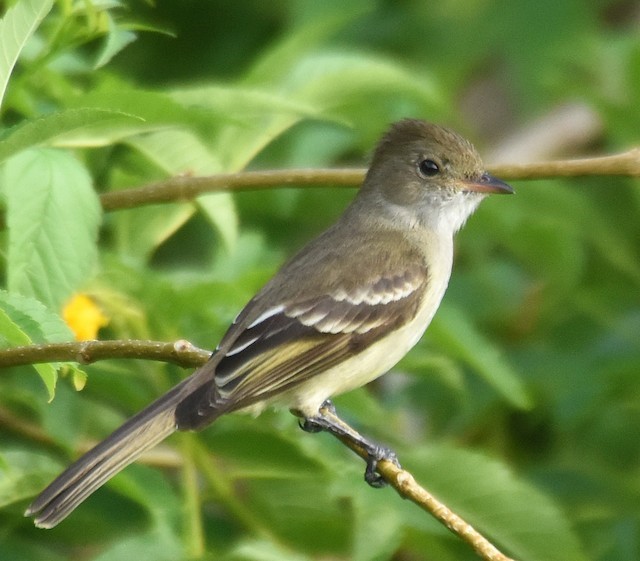
Caye Caulker, Belize. © Ben
Cozumel, Mexico. © Ross Gallardy
Guánica State Forest, Puerto Rico. © Justin Watts
Gros Inlet, St. Lucia. © Arne Thelin
Birdfinding.info ⇒ Locally common to abundant in several parts of its range. Ubiquitous in suitable habitat on the Cayman Islands. In Mexico, most numerous on Cozumel, but can also be found along the “Mexican Riviera” at tourist destinations such as Cancún, Playa del Carmen, and Tulúm. On Puerto Rico, found mainly in dry coastal lowlands, most conspicuous at Cabo Rojo National Wildlife Refuge; also common at La Parguera, Guánica State Forest, and on Vieques. Common and widespread throughout the Virgin and Leeward Islands, and on Guadeloupe, Dominica, St. Lucia, and Barbados. Uncommon or localized on Martinique, St. Vincent, Carriacou, and Grenada. Fairly common on Bonaire and Curaçao. Rare on Aruba—but has been found consistently at Spaans Lagoon.
Caribbean Elaenia
Elaenia martinica
Family: Tyrannidae
Resident in five widely separated areas on the western and eastern rims of the Caribbean:
(1) eastern Yucatán Peninsula (mainly coastal Quintana Roo) and its adjacent islands from Holbox south to Caye Caulker;
(2) the Cayman Islands;
(3) Isla Providencia and San Andrés;
(4) the ABC Islands; and
(5) Puerto Rico south through the Lesser Antilles to Grenada and Barbados.
Occurs mainly in dry woodland and tall brush, and sometimes locally abundant in these habitats. Lesser Antillean populations also inhabit wet montane forests. Occupies mangroves to varying extents in different parts of its range—especially on Providencia and San Andrés.
Western populations (in the first three areas listed above) are sometimes regarded collectively as the “Chinchorro Elaenia” (E. m. cinerascens). In this case, the eastern populations could be called the “Lesser Antillean Elaenia.”
Identification
A typically drab Elaenia with two prominent wingbars. In most of its range, it is the only mid-sized, wing-barred flycatcher present.
The plain upperparts can appear either brownish, olive, or gray. The belly usually has a faint yellowish wash, and the chest is gray.
White central crown stripe is usually concealed.
Seen from below, the lower mandible is mostly pinkish-orange or flesh-colored. From the side, the bill usually appears mostly dark, becoming paler toward the base of the lower mandible.
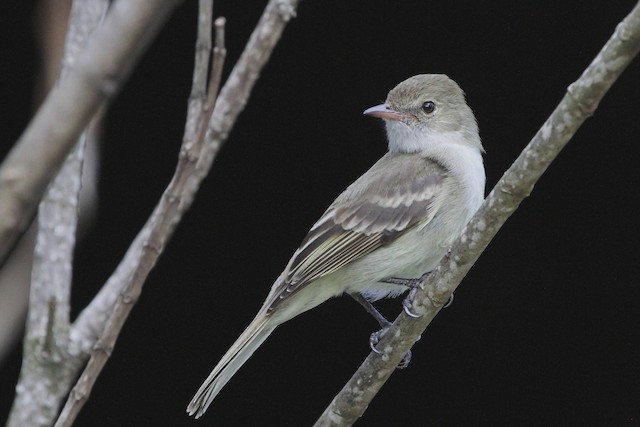
Caribbean Elaenia, E. m. riisii. (Yeptons Pond, Saint John’s, Antigua; February 14, 2014.) © Stephen Gast
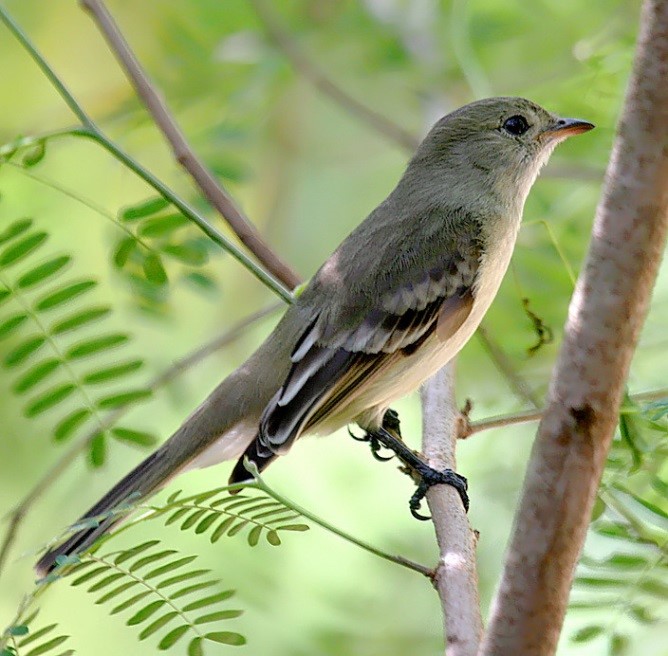
Caribbean Elaenia, E. m. caymanensis—note “dove-headed” resting profile typical of elaenias. (Queen Elizabeth II Botanic Park, Grand Cayman; December 11, 2007.) © Steve Metz

Caribbean Elaenia, E. m. riisii. (Spaans Lagoon, Aruba; April 12, 2013.) © Steven Mlodinow

Caribbean Elaenia, E. m. remota. (Cozumel, Mexico; December 31, 2016.) © Luke Berg
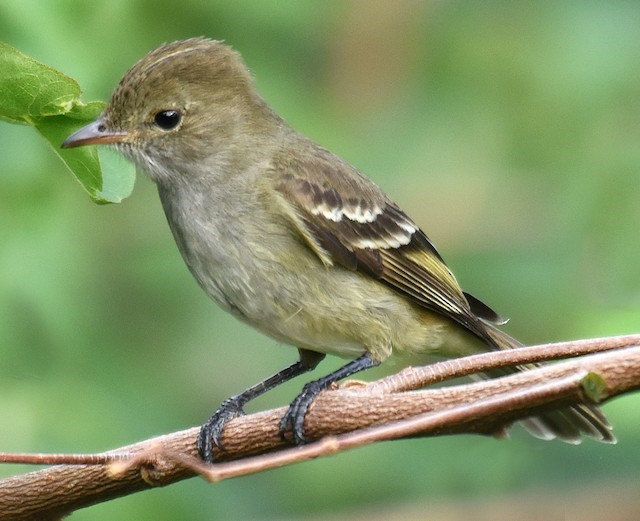
Caribbean Elaenia, E. m. riisii, showing yellowish highlights in secondaries. (Great Salt Pond, St. Kitts; March 4, 2018.) © Steven Mlodinow
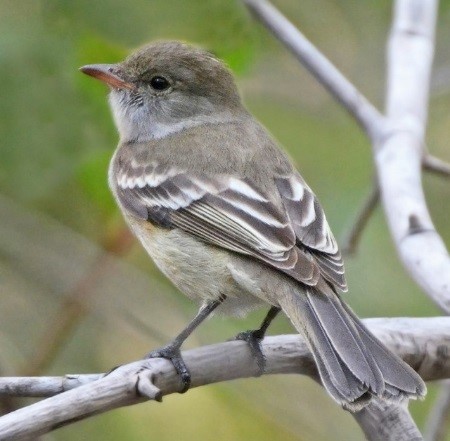
Caribbean Elaenia, E. m. riisii, showing strongly contrasting highlights in flight feathers. (Spaans Lagoon, Aruba; April 12, 2013.) © Steven Mlodinow
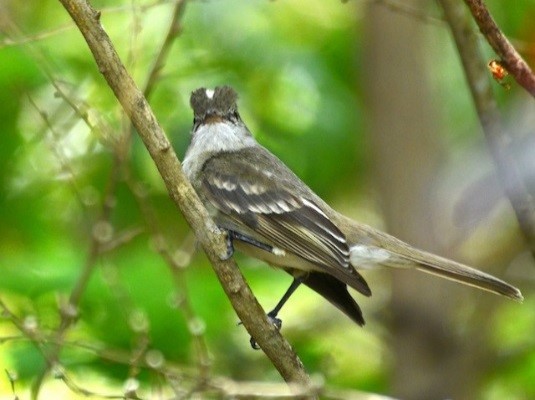
Caribbean Elaenia, E. m. caymanensis, displaying its white crown stripe by flattening head feathers. (Grand Cayman; March 19, 2013.) © Alan Van Norman
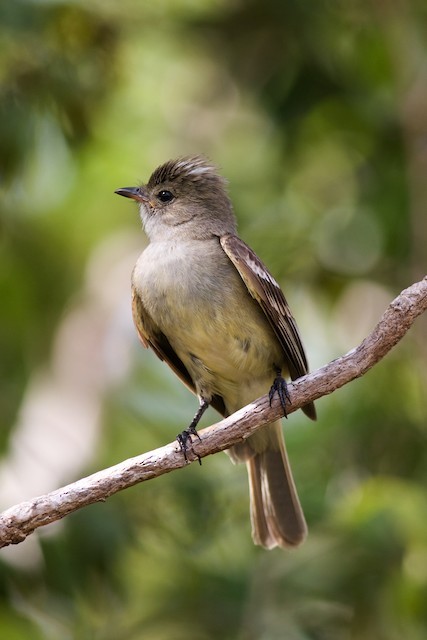
Caribbean Elaenia, E. m. caymanensis, showing white crown stripe by erecting head feathers. (Willie’s Pig Farm, Grand Cayman; May 12, 2008.) © David Disher
In areas where Caribbean Elaenia occurs with similar-looking species (mainly the Yucatán, ABC Islands, and southern Lesser Antilles), it is best recognized by voice—although its vocalizations vary considerably. For comparisons with Yellow-bellied Elaenia, migratory South American elaenias, and Northern Scrub-Flycatcher, see below.
Many Subtle Variations. Within its drab palette, Caribbean Elaenia’s coloration is quite variable. On some, the bill may be paler or darker than usual. The upperparts can be shaded olive, brown, or gray. The wings usually show contrasting highlights, but can be mostly uniform. The underparts often show a faint yellow wash, but may be entirely whitish-gray.
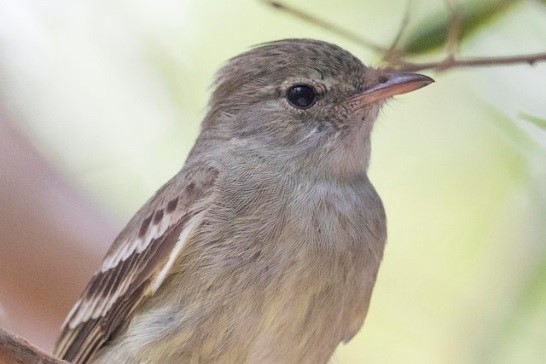
Caribbean Elaenia, E. m. caymanensis. (Queen Elizabeth II Botanic Park, Grand Cayman; March 22, 2017.) © Charmaine Anderson

Caribbean Elaenia, E. m. riisii, with all-black bill—possibly a juvenile, based on molting wings. (Guánica State Forest, Puerto Rico; October 27, 2015.) © Greg Roberts
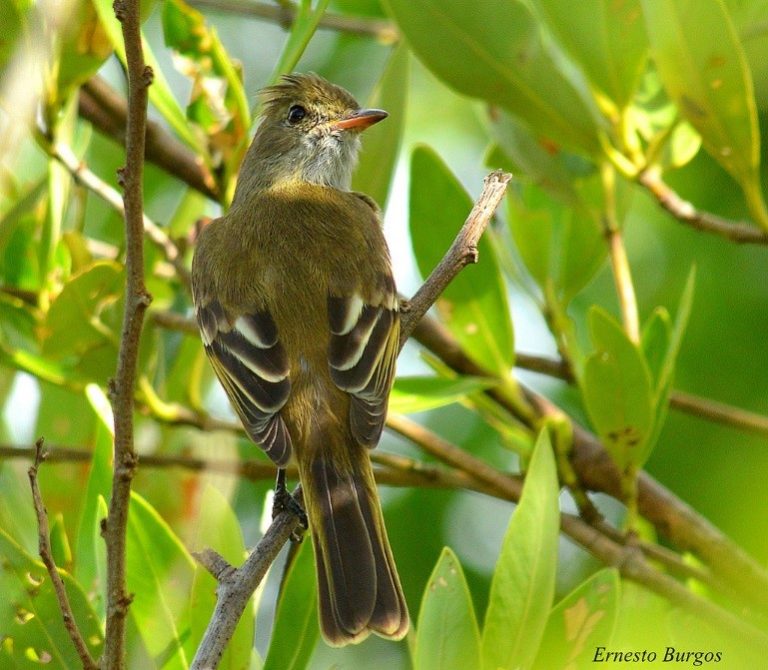
Caribbean Elaenia, E. m. riisii, brighter olive than average. (Aguirre State Forest, Puerto Rico; December 2, 2013.) © Ernesto Burgos
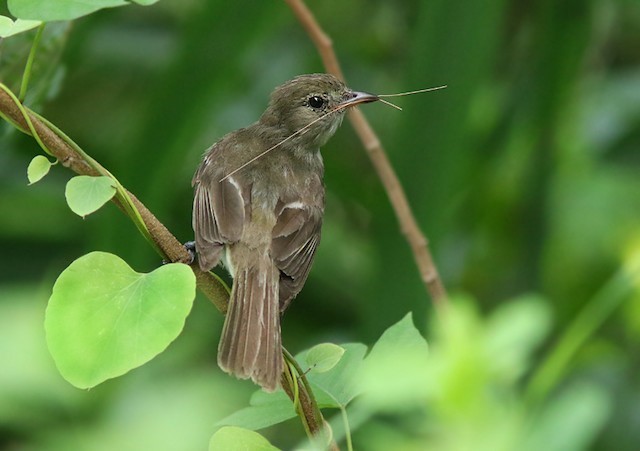
Caribbean Elaenia, E. m. remota, lacking highlights in wings. (San José, Cozumel, Mexico; July 15, 2017.) © Amy McAndrews
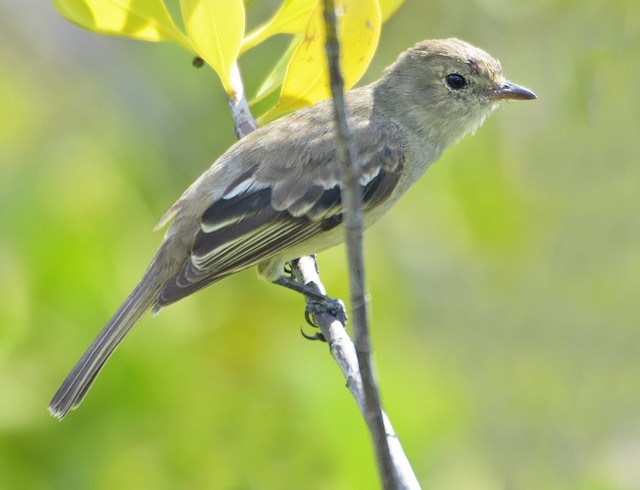
Caribbean Elaenia, E. m. riisii, a pale-gray individual. (West End Pond, Anguilla; February 13, 2017.) © Steven Mlodinow

Caribbean Elaenia, E. m. caymanensis, with faint lemon-yellow wash on belly. (Queen Elizabeth II Botanic Park, Grand Cayman; December 11, 2007.) © Steve Metz
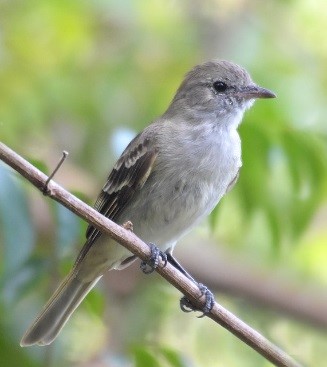
Caribbean Elaenia, E. m. riisii, with plain whitish-gray underparts. (Loterie Farm, St. Martin; February 17, 2017.) © Steven Mlodinow
Voice. Vocalizations vary among and within the various populations.
The “basic” song in many areas is three syllables: two quick whistles, then a rattle: swee-whit-chrrr!
The typical call (at least in some populations) is a crisp, shrill whistle: preeeu!
An alternate call (at least on Isla San Andrés) is a rough ch-r-r-r-r-r rattle:
Eastern Caribbean populations tend to have a richer vocal quality and more diverse vocalizations.
Here a Puerto Rican bird calls and sings variations on the “basic” song:
Here a St. Lucia bird give five different vocalizations:
Cf. Yellow-bellied Elaenia. Along the Yucatán coast and in the Lesser Antilles from St. Vincent to Grenada, Caribbean coexists with the slightly larger and brighter Yellow-bellied Elaenia. They are most reliably distinguished by voice, but other clues may help:
Behavior: Yellow-bellied is typically gregarious and expressive, often raising its bushy crest and showing the white stripe on its crown. Note that Caribbean also a white crown stripe, but exposes it less often.
Belly Color: The yellow wash on Yellow-bellied’s belly is sometimes pronounced but not always a reliable field mark, as it is variable and Caribbean can also show a yellowish wash on the belly.
Bill Color: In most cases, Caribbean’s lower mandible is mostly pale whereas Yellow-bellied’s is mostly black—this detail can be diagnostic, but often difficult to observe.
Cf. Migratory South American Elaenias. Lesser and Small-billed Elaenias have been documented in the ABC Islands, and Chilean Elaenia has been documented in Texas. All could be confused with Caribbean Elaenia.
Lesser Elaenia is visually indistinguishable from Caribbean, but differs in its habits and habitat preference. Lesser is an open-country species that usually perches on low bushes in grassy areas.
Small-billed is very similar to Caribbean but usually shows a distinct white eyering and a third wingbar (Caribbean sometimes shows this as well). Small-billed is a long-distance migrant that could potentially occur as a vagrant anywhere in the Caribbean region.
Chilean Elaenia is an even longer-distance austral migrant with clear potential to stray to the Caribbean region. Chilean is nearly identical to Small-billed, but typically shows a stronger white eyering and only two wingbars.
Cf. Northern Scrub-Flycatcher. In the ABC Islands, the Northern Scrub-Flycatcher is common and somewhat similar to Caribbean Elaenia, but it typically shows a yellower belly, fainter wingbars, and a distinct dark eyestripe and pale superloral bar.
Notes
Polytypic species consisting of seven recognized subspecies: martinica, riisii, barbadensis, remota, chinchorrensis, cinerascens, and caymanensis. The status of some subspecies appears dubious, and it is unclear whether multiple forms or species are included.
Taxonomic Uncertainties. The Caribbean Elaenia been suggested to comprise two distinct forms, potentially separate species:
“Chinchorro Elaenia” (E. m. cinerascens) of the western Caribbean: remota on the eastern Yucatán Peninsula and adjacent islands from Holbox to Cozumel, possibly south to Caye Caulker; chinchorrensis on the offshore keys Banco Chinchorro, Lighthouse Reef, Glover’s Reef, and possibly Caye Caulker; cinerascens on Isla Providencia and San Andrés; and caymanensis on the Cayman Islands.
“Lesser Antillean Elaenia” (E. m. martinica) of the eastern Caribbean: riisii on Puerto Rico, Culebra, Vieques, the Virgin Islands, Anguilla, St. Martin, St. Barthélemy, Antigua, Barbuda, Aruba, Curaçao, and Bonaire; martinica on the Lesser Antilles from Saba and St. Eustatius south to Grenada; and barbadensis on Barbados.
While this division into eastern and western forms seems geographically plausible, the populations do not appear to be differentiated from one another along these lines. Moreover, the recognized subspecies distinctions of the far west and east both appear facially unlikely to be valid:
Riisii and martinica unlikely to represent coherent sets of interrelated populations. As defined in the literature, riisii exists in two widely separated island groups—on the north side of the Caribbean from Puerto Rico to Antigua, and on the south side in the ABC Islands—with martinica occupying the islands in between.
Chinchorrensis is an improbable, or perhaps ephemeral, subspecies. The scattered islands that comprise its range are very small and dispersed, and seem unlikely to support a stable set of populations over a long enough time scale to become or remain distinct from the adjacent Yucatán remota populations.
It seems possible that these subspecies were originally recognized as different due to short-term differences in local populations that arise from the natural variability of Caribbean Elaenias, as described above.
References
eBird. 2019. eBird: An online database of bird distribution and abundance. Cornell Lab of Ornithology, Ithaca, N.Y. http://www.ebird.org. (Accessed January 4, 2019.)
Hosner, P. 2019. Caribbean Elaenia (Elaenia martinica). In Handbook of the Birds of the World Alive (J. del Hoyo, A. Elliott, J. Sargatal, D.A. Christie and E. de Juana, eds.). Lynx Edicions, Barcelona. https://www.hbw.com/node/57141. (Accessed January 3, 2019.)
Howell, S.N.G., I. Lewington, and W. Russell. 2014. Rare Birds of North America. Princeton University Press, Princeton, N.J.
Howell, S.N.G., and S.W. Webb. 1995. A Guide to the Birds of Mexico and Northern Central America. Oxford University Press, Oxford.
Raffaele, H., J. Wiley, O. Garrido, A. Keith, and J. Raffaele. 1998. A Guide to the Birds of the West Indies. Princeton University Press, Princeton, N.J.
Ridgely, R.S., and G. Tudor. 1994. The Birds of South America, Volume II: The Suboscine Passerines. University of Texas Press, Austin.
Wells, J.V., and A.C. Wells. 2017. Birds of Aruba, Bonaire, and Curaçao. Cornell University Press, Ithaca, N.Y.